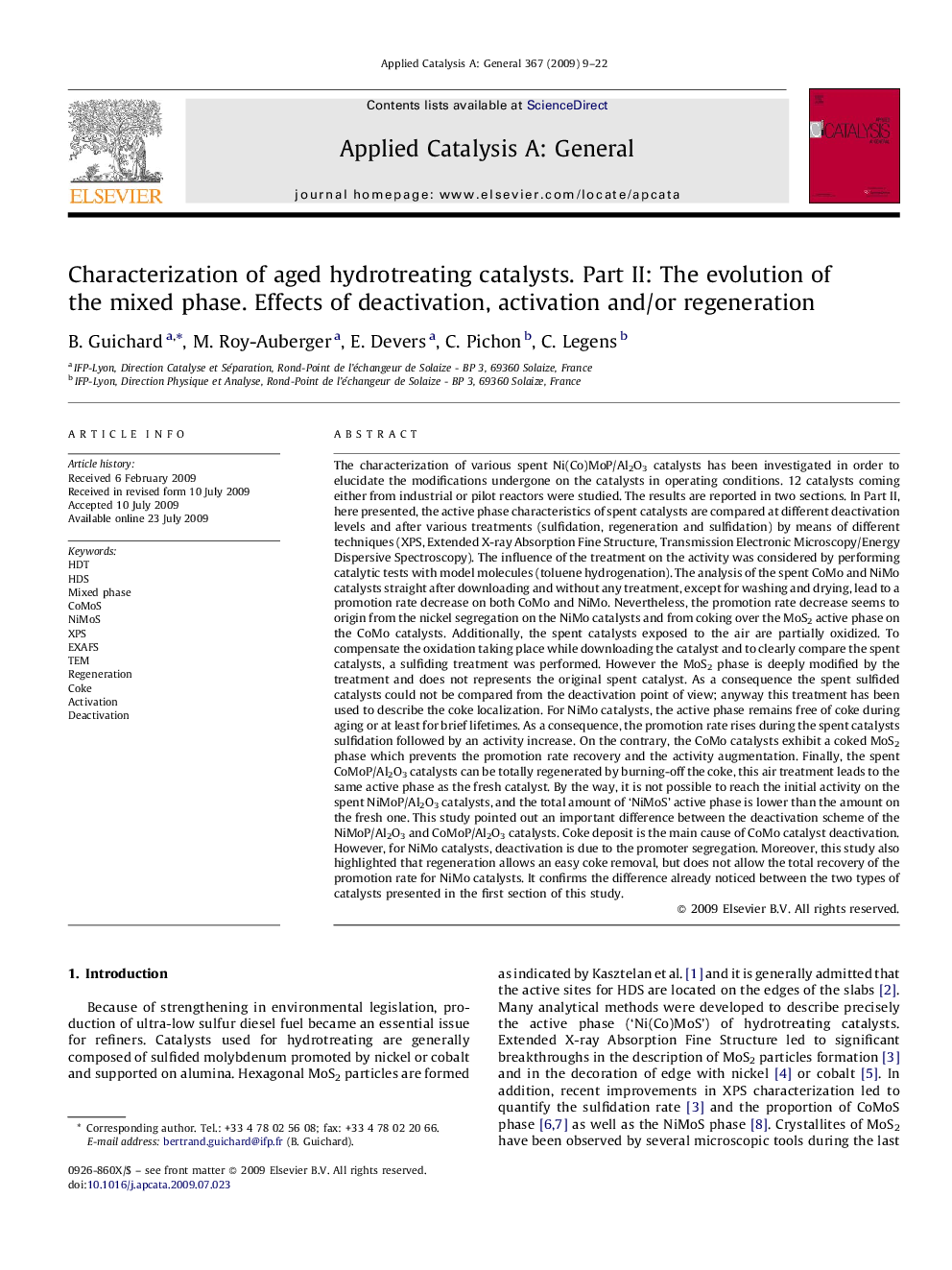| کد مقاله | کد نشریه | سال انتشار | مقاله انگلیسی | نسخه تمام متن |
|---|---|---|---|---|
| 42426 | 45925 | 2009 | 14 صفحه PDF | دانلود رایگان |

The characterization of various spent Ni(Co)MoP/Al2O3 catalysts has been investigated in order to elucidate the modifications undergone on the catalysts in operating conditions. 12 catalysts coming either from industrial or pilot reactors were studied. The results are reported in two sections. In Part II, here presented, the active phase characteristics of spent catalysts are compared at different deactivation levels and after various treatments (sulfidation, regeneration and sulfidation) by means of different techniques (XPS, Extended X-ray Absorption Fine Structure, Transmission Electronic Microscopy/Energy Dispersive Spectroscopy). The influence of the treatment on the activity was considered by performing catalytic tests with model molecules (toluene hydrogenation). The analysis of the spent CoMo and NiMo catalysts straight after downloading and without any treatment, except for washing and drying, lead to a promotion rate decrease on both CoMo and NiMo. Nevertheless, the promotion rate decrease seems to origin from the nickel segregation on the NiMo catalysts and from coking over the MoS2 active phase on the CoMo catalysts. Additionally, the spent catalysts exposed to the air are partially oxidized. To compensate the oxidation taking place while downloading the catalyst and to clearly compare the spent catalysts, a sulfiding treatment was performed. However the MoS2 phase is deeply modified by the treatment and does not represents the original spent catalyst. As a consequence the spent sulfided catalysts could not be compared from the deactivation point of view; anyway this treatment has been used to describe the coke localization. For NiMo catalysts, the active phase remains free of coke during aging or at least for brief lifetimes. As a consequence, the promotion rate rises during the spent catalysts sulfidation followed by an activity increase. On the contrary, the CoMo catalysts exhibit a coked MoS2 phase which prevents the promotion rate recovery and the activity augmentation. Finally, the spent CoMoP/Al2O3 catalysts can be totally regenerated by burning-off the coke, this air treatment leads to the same active phase as the fresh catalyst. By the way, it is not possible to reach the initial activity on the spent NiMoP/Al2O3 catalysts, and the total amount of ‘NiMoS’ active phase is lower than the amount on the fresh one. This study pointed out an important difference between the deactivation scheme of the NiMoP/Al2O3 and CoMoP/Al2O3 catalysts. Coke deposit is the main cause of CoMo catalyst deactivation. However, for NiMo catalysts, deactivation is due to the promoter segregation. Moreover, this study also highlighted that regeneration allows an easy coke removal, but does not allow the total recovery of the promotion rate for NiMo catalysts. It confirms the difference already noticed between the two types of catalysts presented in the first section of this study.
XPS and EXAFS analysis reveal an important difference between the deactivation scheme of the NiMoP/Al2O3 and CoMoP/Al2O3 catalysts. Some regeneration and sulfidation experiments enable to determine the coke deposit weight in the catalyst activity. The deactivation origins mainly from the coke deposit with CoMo catalysts whereas it comes from nickel segregation for NiMo catalysts.Figure optionsDownload as PowerPoint slide
Journal: Applied Catalysis A: General - Volume 367, Issues 1–2, 1 October 2009, Pages 9–22